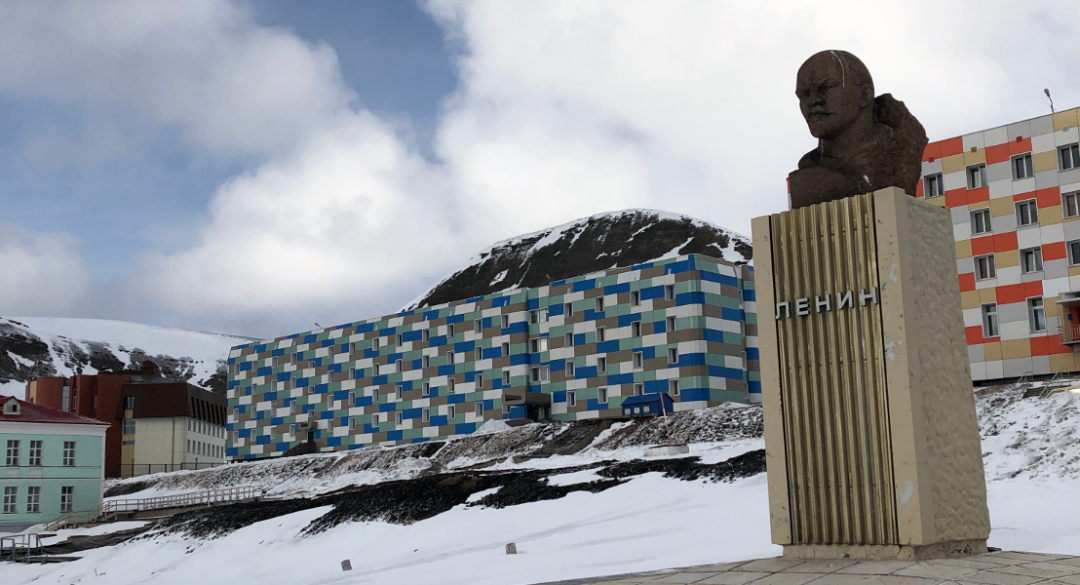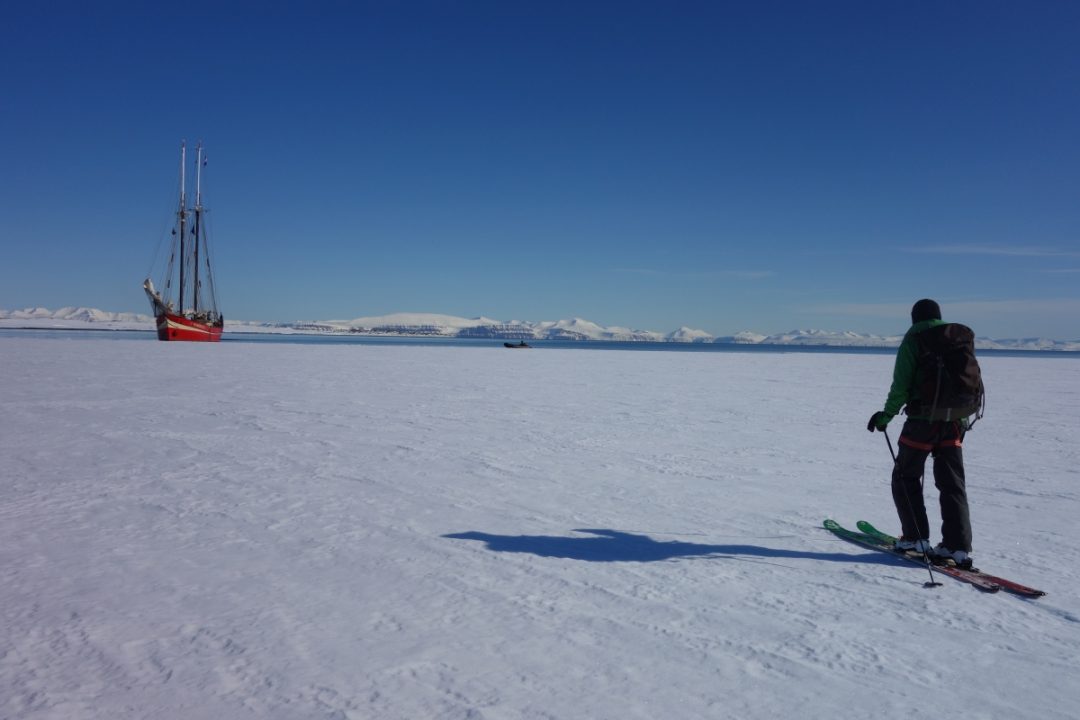
After another bluebird day and two laps from an unnamed summit, we return to the waiting Zodiac, and eventually the Noorderlicht. Photo credit: Rob Coppolillo
Polar bears, schooners and endless ski lines
As close to the North Pole as it is to mainland Europe, the Svalbard archipelago delivers all the ingredients of true adventure-skiing: unforgettable landscapes, once-in-a-lifetime experiences, some fantastic skiing, and stories you’ll tell for the rest of your life. Where else can you have a near-miss with a polar bear, enjoy 3000 feet of pristine corn, share a beer under full sail on a 150-foot sailboat, discuss Muay Thai boxing with a Dutch weightlifter, photo your friends with a bust of Lenin, and summit an unclimbed peak, all in the same day?
TRIP BETA
Location: Svalbard Archipelago, Norway
Aspects: all of ‘em
Starting point: Longyearbyen Harbor
Distance: six days, hundreds of kilometers by boat and by ski
Time: May 22-29, 2019
Top elevation: 3200 feet
Vertical: lots
USGS map: none (Svalbardguiden app!)
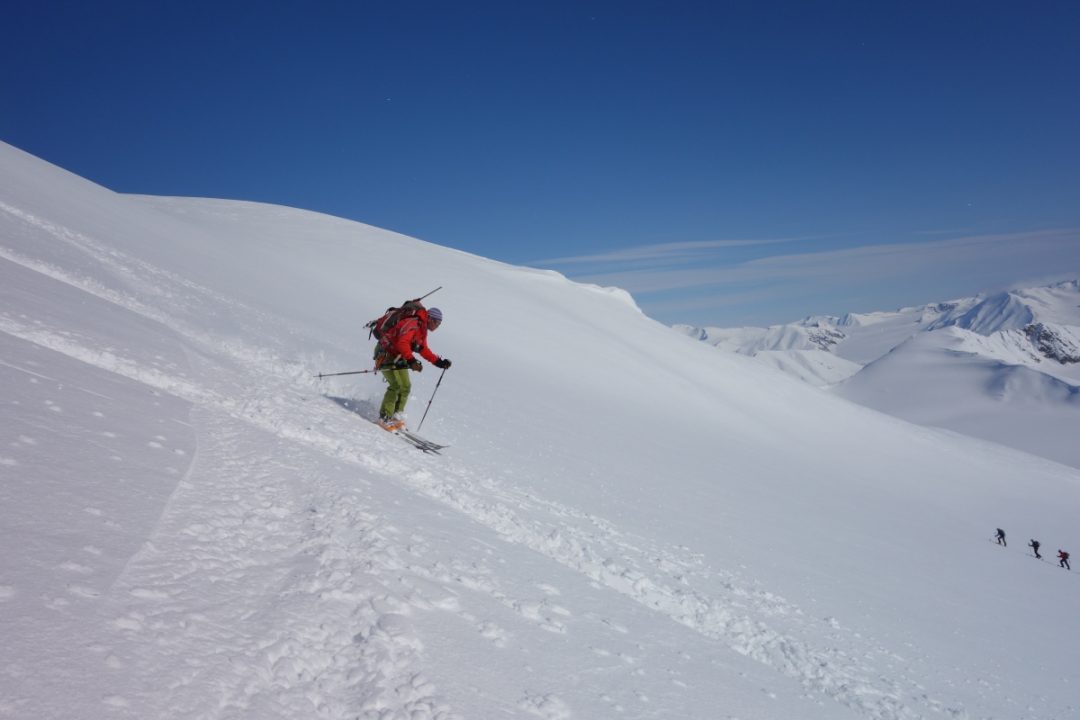
Expedition leader Phil Wickens enjoys sun-softened snow with glaciers disappearing into the horizon … and three teammates coming back up the skintrack for another serving. PC: Rob Coppolillo
“Robert, the bear is moving north, approximately 250m from where you are now. He is walking at you.” –Captain Floris
*
“Seals. It’s seals talking to each other.” –Tom Wolfe, IFMGA/ACMG mountain guide
*
“I have no idea if anyone has skied off this peak. Good question!” –Phil Wickens, Expedition Leader, Oceanwide Expeditions
*
The first mention of Svalbard comes from an Icelandic saga, around 1200, which describes an island four days sailing to the north and east. There’s no archaeological evidence that humans had set up shop on Svalbard, though. It appears Inuit migrations ended in Greenland, meaning the polar bears and Arctic foxes ran the place until the Euros began visiting more regularly after 1600. Dutch, Russian, English, Norwegian, and French sailors visited the islands throughout history, but it wasn’t until 1920 that the Svalbard Treaty officially designated the islands as part of Norway. An agreement between signatories granted access to natural resources, which means whaling and mining by other countries could continue — this notably resulted in two Russian outposts on the island, Barentsburg and Pyramiden. Comrade Lenin makes his appearances in these villages.
Covered by sixty-percent glaciers with more polar bears than people, Svalbard presents a few challenges to the adventurous skier: yes, the bears, but also–how to get around? Dog-sled teams can get you just about anywhere, until the seasonal snow ends. The capital town, Longyearbyen, has several hundred snowmobiles parked just about everywhere, also pretty useful until the snow melts around town and the cracks open up on the glaciers. There’s about 50km of roads in and around Longyear, so not much help there.
The answer? The boat. My colleague, Tom Wolfe; a full mountain guide from Canmore, Alberta; came home from his 2018 trip as psyched on the boat as he was on the skiing. “Wait ‘til you see the Noorderlicht,” he said. “You can’t believe this thing–it’s 45 meters, a two-masted schooner with a chef and this captain, Floris–you’re going to love this guy.”
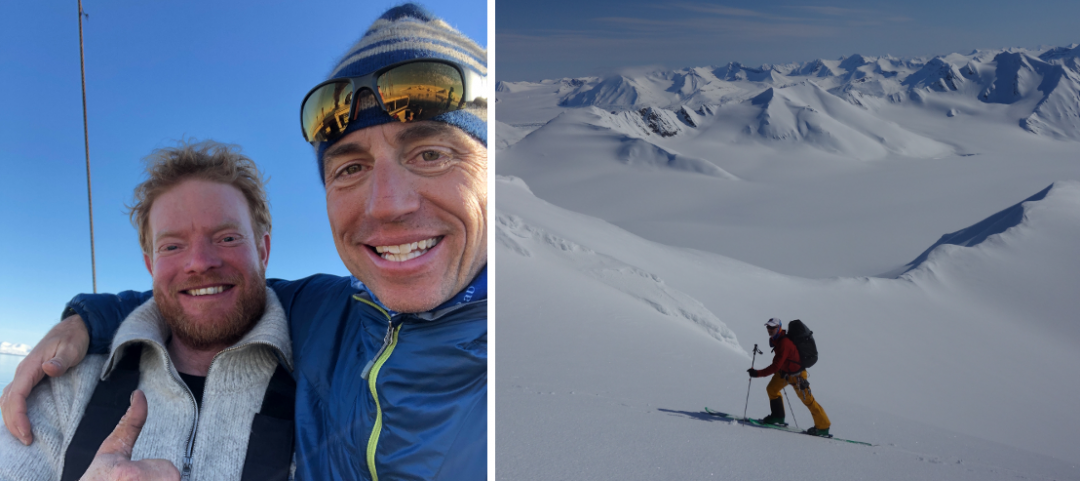
Left: The crazy Dutchman, Floris de Waard, captain of the Noorderlicht, and the author. Right: King Grant ascends Svalbard’s sea of glaciers and summits.
Having now spent a week on the boat with him, I do love Floris. He’s a kook…and a great boat captain! Tom wasn’t joking, either. The Noorderlicht (“Northern Lights” in Dutch) made a great home base for us. Dogs and snow machines aren’t as comfortable or convenient for a team of skiers headed onto the glaciers and peaks of Svalbard, so once the sea ice retreats a bit, the Noorderlicht grants access to fjords and channels and unskied peaks on the northwest side of the islands. Awesome.
And then there’s the wildlife. When Tom arrived back in harbor in 2018, he immediately texted me, “You’re coming next year. This is so cool!” We put down a deposit on the boat before he’d left Svalbard, just like we did this year, after our 2019 voyage. The boat, the ski-mountaineering, the crew, the experience, were all-time, but the wildlife sealed the deal for me. You won’t see bears in Iceland or Antarctica. Or caribou. Arctic foxes poke their heads up, checking out the group. They’re tiny, the size of a house cat!
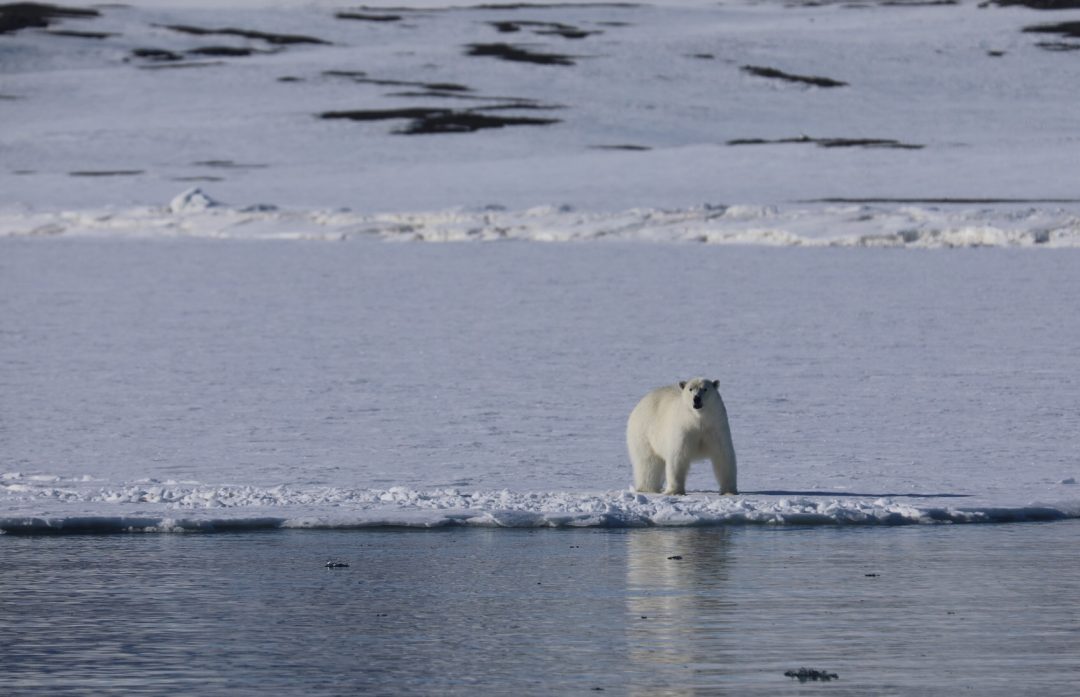
Ursus maritimus, or “maritime bear,” or “isbjørn” (ice bear) in Norwegian, or just a polar bear to us gringos. They feed on seals and spend most of their lives on the sea ice. PC: Rob Coppilillo
Oh, and the skiing? Did I mention the skiing? Yes, right. A typical day: guides meet at 06:30 over fresh coffee, eat breakfast, load the Zodiac, scope a landing, shuttle the team ashore, watch for bears, and then…tour. We leave the gleaming sea ice and a saturated blue sea, aiming for peaks still blanketed in the winter’s snow. We had a meter-and-a-half snowpack still on the ground this May, which granted us GS turns from summits, our skis pointed at the speck of the boat, kilometers away and anchored in a shimmering fjord. Still a thousand feet above the sea, we spot polar bear tracks, traversing between seal holes. We choose our line onto the ice with care: fall-line turns towards a calving glacier, but avoiding blind spots where we might spook a hunting bear. Heads up!
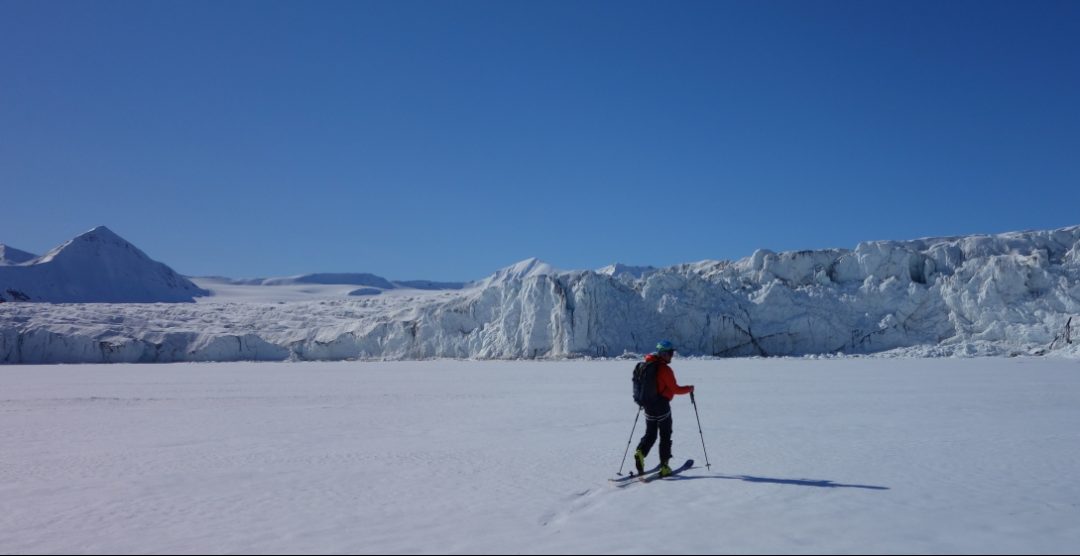
Skinning across the surface of the frozen ocean, Cooper Caillier approaches teetering seracs on Spitsbergen.
By day four we’re negotiating a deposit for 2020. Tom and I chat with Captain Floris while he steers the ship at nine p.m., the sun still high in the sky, no sign of it setting, as we sail into open water and head towards yet another fjord. More skiing to be done. See more here.
This is the first in a series of essays and trip reports from the Svalbard Archipelago, so stay tuned for more over the coming months!
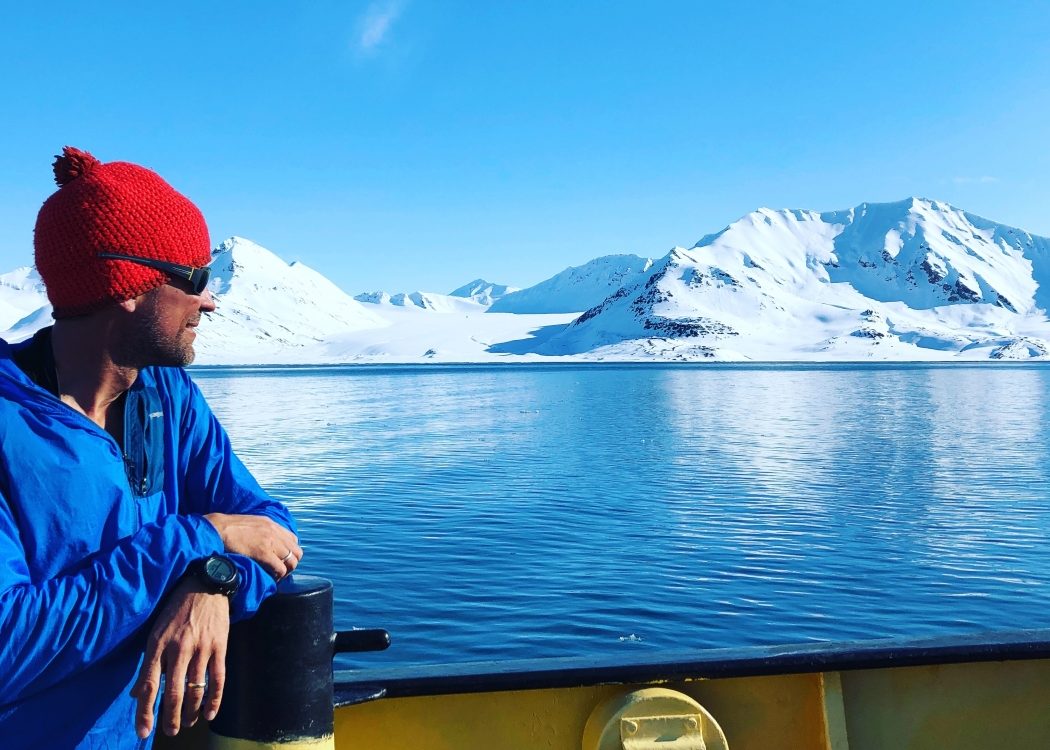
Tom Wolfe, IFMGA/ACMG mountain guide, relaxing after another stellar day touring and sailing in Svalbard.
Rob Coppolillo is WildSnow’s official “Mud Season Correspondent” and an IFMGA/AMGA full mountain guide, newly based in Chamonix, France. He and Tom will sail again in Svalbard, May 9-16, 2020, aboard the Noorderlicht with Captain Floris.
Rob Coppolillo is a mountain guide and writer, based on Vashon Island, in Puget Sound. He’s the author of The Ski Guide Manual.

